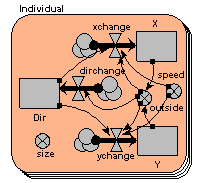Main menu
You are here
Model entry
| Search | Simulistics | Model catalogue | Listed by keyword | Listed by ID | Listed by title | Listed by date added |
Basic animal/particle movement model
Model : move1
Simile version : 3.1+
Date added : 2003-06-25
Keywords :
Movement ;
Individual-based ;
Particles ;
Description
This is a basic random-walk model for a set of individuals in 2D space. The individuals could represent animals wandering around on a plane surface.
An individual has a tendency to keep on moving in the same direction, but in any one time step can deviate to left or right. The deviation is determined randomly, by selecting a value from a random distribution with a mean of 0 (degrees). If the spread of this distribution is large (say, from -50 degrees to +50 degrees), the animal will have a very windy path. If the spread is small (say, -2 degrees to +2 degrees), the animal’s path will be pretty straight.
When the animal reaches the edge of the area (100x100 units), it reverses direction.
Because the movement model is inside a multiple-instance submodel, we are modelling the movement of a collection of individuals. Note that, in this model, there is no interaction between these individuals: they all move independently of each other. To add interaction between individuals into this model, we would need to add an association submodel, with a condition that makes an association between two individuals when they are within a certain distnace of each other.
Files
Model fileClick on the icon to download the model file. (You will need Simile to examine and run the model. A free evaluation version is available from the products page.) Some browsers may attempt to display the model file, rather than open it in Simile; in this case, use the browser back button to return to this page, and use the context menu (invoked by right-clicking on the link) to save the target file to disk. |
|
|
|
|
Diagram

Results
|The following image (animated when viewed in a web browser) shows the position of the individuals at the start of the simulation, and at intervals thereafter.

Copyright 2003-2024 Simulistics Ltd
